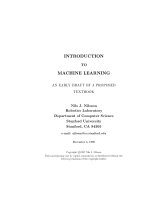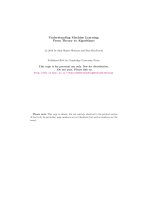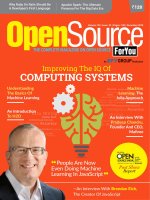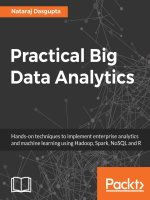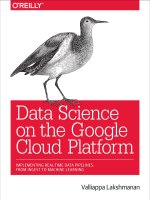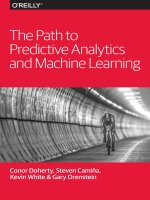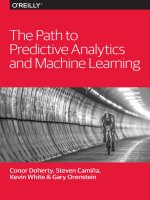Trí tuệ nhân tạo - Introduction to Machine Learning
Bạn đang xem bản rút gọn của tài liệu. Xem và tải ngay bản đầy đủ của tài liệu tại đây (2.35 MB, 212 trang )
www.GetPedia.com
* The Ebook starts from the next page : Enjoy !
INTRODUCTION
TO
MACHINE LEARNING
AN EARLY DRAFT OF A PROPOSED
TEXTBOOK
Nils J. Nilsson
Rob otics Lab oratory
Department of Computer Science
Stanford University
Stanford, CA 94305
e-mail:
September 26, 1996
Copyright
c
1996 Nils J. Nilsson
This material may not be copied, reproduced, or distributed without the
written permission of the copyright holder. It is being made available on
the world-wide web in draft form to students, faculty, and researchers
solely for the purpose of preliminary evaluation.
Contents
1 Preliminaries 1
1.1 Introduction :::::: ::::::: ::::::: ::::::: 1
1.1.1 What is Machine Learning? ::::::: ::::::: 1
1.1.2 Wellsprings of Machine Learning :::: ::::::: 3
1.1.3 Varieties of Machine Learning :::::: ::::::: 5
1.2 Learning Input-Output Functions ::::: ::::::: ::: 6
1.2.1 Types of Learning ::::: ::::::: ::::::: 6
1.2.2 Input Vectors ::::: ::::::: ::::::: ::: 8
1.2.3 Outputs :::: ::::::: ::::::: ::::::: 9
1.2.4 Training Regimes :::::: ::::::: ::::::: 9
1.2.5 Noise ::::: ::::::: ::::::: ::::::: 10
1.2.6 Performance Evaluation :::::: ::::::: ::: 10
1.3 Learning Requires Bias ::::::: ::::::: ::::::: 10
1.4 Sample Applications ::::: ::::::: ::::::: ::: 13
1.5 Sources ::::: ::::::: ::::::: ::::::: ::: 14
1.6 Bibliographical and Historical Remarks :::: ::::::: 15
2 Boolean Functions 17
2.1 Representation :::: ::::::: ::::::: ::::::: 17
2.1.1 Boolean Algebra :::::: ::::::: ::::::: 17
2.1.2 Diagrammatic Representations ::::: ::::::: 18
2.2 Classes of Boolean F
unctions ::::::: ::::::: ::: 19
2.2.1 Terms and Clauses ::::: ::::::: ::::::: 19
2.2.2 DNF Functions ::::::: ::::::: ::::::: 20
i
2.2.3 CNF Functions ::::::: ::::::: ::::::: 24
2.2.4 Decision Lists ::::: ::::::: ::::::: ::: 25
2.2.5 Symmetric and Voting Functions :::: ::::::: 26
2.2.6 Linearly Separable Functions :::::: ::::::: 26
2.3 Summary ::::::: ::::::: ::::::: ::::::: 27
2.4 Bibliographical and Historical Remarks :::: ::::::: 28
3 Using Version Spaces for Learning 29
3.1 Version Spaces and Mistake Bounds :::::: ::::::: 29
3.2 Version Graphs :::: ::::::: ::::::: ::::::: 31
3.3 Learning as SearchofaVersion Space ::::: ::::::: 34
3.4 The Candidate Elimination Method :::::: ::::::: 35
3.5 Bibliographical and Historical Remarks :::: ::::::: 37
4 Neural Networks 39
4.1 Threshold Logic Units ::::::: ::::::: ::::::: 39
4.1.1 Denitions and Geometry ::::: ::::::: ::: 39
4.1.2 Special Cases of Linearly Separable Functions :::: 41
4.1.3 Error-Correction Training of a TLU :::::: ::: 42
4.1.4 Weight Space ::::: ::::::: ::::::: ::: 45
4.1.5 The Widrow-Ho Procedure ::::::: ::::::: 46
4.1.6 Training a TLU on Non-Linearly-Separable Training
Sets :::::: ::::::: ::::::: ::::::: 49
4.2 Linear Mac
hines ::::::: ::::::: ::::::: ::: 50
4.3 Networks of TLUs :::::: ::::::: ::::::: ::: 51
4.3.1 Motivation and Examples ::::: ::::::: ::: 51
4.3.2 Madalines ::::::: ::::::: ::::::: ::: 54
4.3.3 Piecewise Linear Machines ::::: ::::::: ::: 56
4.3.4 Cascade Networks ::::: ::::::: ::::::: 57
4.4 Training Feedforward Networks byBackpropagation :::: 58
4.4.1 Notation :::: ::::::: ::::::: ::::::: 58
4.4.2 The Backpropagation Method :::::: ::::::: 60
4.4.3 Computing Weight Changes in the Final Layer ::: 62
4.4.4 Computing Changes to the Weights in Intermediate
Layers ::::: ::::::: ::::::: ::::::: 64
ii
4.4.5 Variations on Backprop :::::: ::::::: ::: 66
4.4.6 An Application: Steering a Van ::::: ::::::: 66
4.5 Synergies Between Neural Network and Knowledge-Based
Methods ::::: ::::::: ::::::: ::::::: ::: 68
4.6 Bibliographical and Historical Remarks :::: ::::::: 68
5 Statistical Learning 69
5.1 Using Statistical Decision Theory ::::: ::::::: ::: 69
5.1.1 Background and General Method :::: ::::::: 69
5.1.2 Gaussian (or Normal) Distributions :::::: ::: 71
5.1.3 Conditionally Independent Binary Components ::: 75
5.2 Learning Belief Networks ::::: ::::::: ::::::: 77
5.3 Nearest-Neighbor Methods ::::: ::::::: ::::::: 77
5.4 Bibliographical and Historical Remarks :::: ::::::: 79
6 Decision Trees 81
6.1 Denitions ::::::: ::::::: ::::::: ::::::: 81
6.2 Supervised Learning of Univariate Decision Trees :::::: 83
6.2.1 Selecting the Type of Test ::::: ::::::: ::: 83
6.2.2 Using Uncertainty Reduction to Select Tests :::: 84
6.2.3 Non-Binary Attributes ::::::: ::::::: ::: 88
6.3 Networks Equivalent to Decision Trees
::::: ::::::: 88
6.4 Overtting and Evaluation :::: ::::::: ::::::: 89
6.4.1 Overtting :::::: ::::::: ::::::: ::: 89
6.4.2 Validation Methods :::: ::::::: ::::::: 90
6.4.3 Avoiding Overtting in Decision Trees ::::: ::: 91
6.4.4 Minimum-Description Length Methods ::::: ::: 92
6.4.5 Noise in Data ::::: ::::::: ::::::: ::: 93
6.5 The Problem of Replicated Subtrees :::::: ::::::: 94
6.6 The Problem of Missing Attributes ::::::: ::::::: 96
6.7 Comparisons ::::: ::::::: ::::::: ::::::: 96
6.8 Bibliographical and Historical Remarks :::: ::::::: 96
iii
7 Inductive Logic Programming 97
7.1 Notation and Denitions :::::: ::::::: ::::::: 99
7.2 A Generic ILP Algorithm ::::: ::::::: ::::::: 100
7.3 An Example :::::: ::::::: ::::::: ::::::: 103
7.4 Inducing Recursive Programs ::::::: ::::::: ::: 107
7.5 Choosing Literals to Add ::::: ::::::: ::::::: 110
7.6 Relationships Between ILP and Decision Tree Induction :: 111
7.7 Bibliographical and Historical Remarks :::: ::::::: 114
8 Computational Learning Theory 117
8.1 Notation and Assumptions for PAC Learning Theory :::: 117
8.2 PAC Learning ::::: ::::::: ::::::: ::::::: 119
8.2.1 The Fundamental Theorem ::::::: ::::::: 119
8.2.2 Examples ::::::: ::::::: ::::::: ::: 121
8.2.3 Some Properly PAC-Learnable Classes ::::: ::: 122
8.3 The Vapnik-Chervonenkis Dimension :::::: ::::::: 124
8.3.1 Linear Dichotomies ::::: ::::::: ::::::: 124
8.3.2 Capacity ::::::: ::::::: ::::::: ::: 126
8.3.3 A More General Capacity Result :::: ::::::: 127
8.3.4 Some Facts and Speculations About the VC Dimension 129
8.4 VC Dimension and PAC Learning ::::::: ::::::: 129
8.5 Bibliographical and Historical Remarks
:::: ::::::: 130
9 Unsupervised Learning 131
9.1 What is Unsupervised Learning? ::::: ::::::: ::: 131
9.2 Clustering Methods :::::: ::::::: ::::::: ::: 133
9.2.1 A Method Based on Euclidean Distance ::::::: 133
9.2.2 A Method Based on Probabilities :::: ::::::: 136
9.3 Hierarchical Clustering Methods ::::: ::::::: ::: 138
9.3.1 A Method Based on Euclidean Distance ::::::: 138
9.3.2 A Method Based on Probabilities :::: ::::::: 138
9.4 Bibliographical and Historical Remarks :::: ::::::: 143
iv
10 Temporal-Dierence Learning 145
10.1 Temporal Patterns and Prediction Problems :::::: ::: 145
10.2 Supervised and Temporal-Dierence Methods ::::: ::: 146
10.3 Incremental Computation of the (W)
i
:::: ::::::: 148
10.4 An Experiment with TD Methods ::::::: ::::::: 150
10.5 Theoretical Results :::::: ::::::: ::::::: ::: 152
10.6 Intra-Sequence Weight Updating ::::: ::::::: ::: 153
10.7 An Example Application: TD-gammon ::::: ::::::: 155
10.8 Bibliographical and Historical Remarks :::: ::::::: 156
11 Delayed-Reinforcement Learning 159
11.1 The General Problem ::::::: ::::::: ::::::: 159
11.2 An Example :::::: ::::::: ::::::: ::::::: 160
11.3 Temporal Discounting and Optimal Policies :::::: ::: 161
11.4 Q-Learning :::::: ::::::: ::::::: ::::::: 164
11.5 Discussion, Limitations, and Extensions of Q-Learning ::: 167
11.5.1 An Illustrative Example :::::: ::::::: ::: 167
11.5.2 Using Random Actions :::::: ::::::: ::: 169
11.5.3 Generalizing Over Inputs ::::: ::::::: ::: 170
11.5.4 Partially Observable States ::::::: ::::::: 171
11.5.5 Scaling Problems :::::: ::::::: ::::::: 172
11.6 Bibliographical and Historical Remarks :::: ::::::: 173
12 Explanation-Based Learning 175
12.1 Deductive Learning :::::: ::::::: ::::::: ::: 175
12.2 Domain Theories ::::::: ::::::: ::::::: ::: 176
12.3 An Example :::::: ::::::: ::::::: ::::::: 178
12.4 Ev
aluable Predicates ::::: ::::::: ::::::: ::: 182
12.5 More General Proofs ::::: ::::::: ::::::: ::: 183
12.6 Utility of EBL :::: ::::::: ::::::: ::::::: 183
12.7 Applications :::::: ::::::: ::::::: ::::::: 183
12.7.1 Macro-Operators in Planning :::::: ::::::: 184
12.7.2 Learning SearchControl Knowledge :::::: ::: 186
12.8 Bibliographical and Historical Remarks :::: ::::::: 187
v
vi
Preface
These notes are in the process of becoming a textbo ok. The process is quite
unnished, and the author solicits corrections, criticisms, and suggestions
from students and other readers. Although I have tried to eliminate errors,
some undoubtedly remain|caveat lector. Manytypographical infelicities
will no doubt persist until the nal version. More material has yet to
be added. Please let me haveyour suggestions about topics that are too Some of my
plans for
additions and
other
reminders are
mentioned in
marginal notes.
important to be left out. I hope that future versions will cover Hopeld
nets, Elman nets and other recurrent nets, radial basis functions, grammar
and automata learning, genetic algorithms, and Bayes networks :::.Iam
also collecting exercises and pro ject suggestions which will appear in future
versions. Yes, the nal version will have a goo d index.
My intention is to pursue a middle ground between a theoretical text-
bo ok and one that focusses on applications. The bo ok concentrates on the
important ideas in machine learning. I do not giveproofsofmany of the
theorems that I state, but I do give plausibility arguments and citations to
formal proofs. And, I do not treat many matters that would be of practical
importance in applications the bo ok is not a handbo ok of machine learn-
ing practice. Instead, my goal is to give the reader sucient preparation
to make the extensive literature on machine learning accessible.
Students in my Stanford courses on machine learning have already made
several useful suggestions, as havemy colleague, Pat Langley,andmy teac
h-
ing assistants, Ron Kohavi, Karl Peger, Robert Allen, and Lise Getoor.
vii
Chapter 1
Preliminaries
1.1 Intro duction
1.1.1 What is Machine Learning?
Learning, likeintelligence, covers such a broad range of pro cesses that it is
dicult to dene precisely. A dictionary denition includes phrases suchas
\to gain knowledge, or understanding of, or skill in, bystudy, instruction,
or exp erience," and \mo dication of a b ehavioral tendency by exp erience."
Zo ologists and psychologists study learning in animals and humans. In
this b o ok we fo cus on learning in machines. There are several parallels
between animal and machine learning. Certainly,many techniques in ma-
chine learning derive from the eorts of psychologists to makemoreprecise
their theories of animal and human learning through computational mo d-
els. It seems likely also that the concepts and techniques b eing explored by
researchers in machine learning may illuminate certain asp ects of biological
learning.
As regards machines, wemightsay,very broadly,thatamachine learns
whenever it changes its structure, program, or data (based on its inputs
or in resp onse to external information) in such a manner that its exp ected
future p erformance improves. Some of these changes, such as the addition
of a record to a data base, fall comfortably within the province of other dis-
ciplines and are not necessarily b etter understo o d for b eing called learning.
But, for example, when the p erformance of a sp eech-recognition machine
improves after hearing several samples of a p erson's sp eech, we feel quite
justied in that case to say that the machine has learned.
1
2 CHAPTER 1. PRELIMINARIES
Machine learning usually refers to the changes in systems that p erform
tasks asso ciated with articial intel ligence (AI). Such tasks involve recog-
nition, diagnosis, planning, rob ot control, prediction, etc. The \changes"
might b e either enhancements to already p erforming systems or ab initio
synthesis of new systems. To b e slightly more sp ecic, weshow the archi-
tecture of a typical AI \agent" in Fig. 1.1. This agent p erceives and mo dels
its environment and computes appropriate actions, p erhaps byanticipating
their eects. Changes made to any of the comp onents shown in the gure
might count as learning. Dierent learning mechanisms might b e employed
dep ending on which subsystem is b eing changed. We will study several
dierent learning metho ds in this b o ok.
Sensory signals
Perception
Actions
Action
Computation
Model
Planning and
Reasoning
Goals
Figure 1.1: An AI System
One might ask \Why should machines have to learn? Why not design
machines to p erform as desired in the rst place?" There are several reasons
why machine learning is imp ortant. Of course, wehave already mentioned
that the achievement of learning in machines might help us understand how
animals and humans learn. But there are imp ortant engineering reasons as
well. Some of these are:
Introduction to Machine Learning
c
1996 Nils J. Nilsson. All rights reserved.
1.1. INTRODUCTION 3
Some tasks cannot b e dened well except by example that is, we
might b e able to sp ecify input/output pairs but not a concise rela-
tionship b etween inputs and desired outputs. Wewould like machines
to b e able to adjust their internal structure to pro duce correct out-
puts for a large numb er of sample inputs and thus suitably constrain
their input/output function to approximate the relationship implicit
in the examples.
It is p ossible that hidden among large piles of data are imp ortant
relationships and correlations. Machine learning metho ds can often
b e used to extract these relationships (data mining).
Human designers often pro duce machines that do not workaswell as
desired in the environments in which they are used. In fact, certain
characteristics of the working environmentmight not b e completely
known at design time. Machine learning metho ds can b e used for
on-the-job improvement of existing machine designs.
The amount of knowledge available ab out certain tasks mightbe
to o large for explicit enco ding byhumans. Machines that learn this
knowledge gradually might b e able to capture more of it than humans
would want to write down.
Environments change over time. Machines that can adapt to a chang-
ing environmentwould reduce the need for constant redesign.
New knowledge ab out tasks is constantly b eing discovered byh
umans.
Vo cabulary changes. There is a constant stream of new events in
the world. Continuing redesign of AI systems to conform to new
knowledge is impractical, but machine learning metho ds mightbe
able to trackmuchofit.
1.1.2 Wellsprings of Machine Learning
Workinmachine learning is nowconverging from several sources. These
dierent traditions each bring dierent metho ds and dierentvo cabulary
which are now b eing assimilated into a more unied discipline. Here is a
brief listing of some of the separate disciplines that havecontributed to
machine learning more details will follow in the the appropriate chapters:
Statistics: A long-standing problem in statistics is how b est to use
samples drawn from unknown probability distributions to help decide
from which distribution some new sample is drawn. A related problem
Introduction to Machine Learning
c
1996 Nils J. Nilsson. All rights reserved.
4 CHAPTER 1. PRELIMINARIES
is how to estimate the value of an unknown function at a new p oint
given the values of this function at a set of sample p oints. Statistical
metho ds for dealing with these problems can b e considered instances
of machine learning b ecause the decision and estimation rules dep end
on a corpus of samples drawn from the problem environment. We
will explore some of the statistical metho ds later in the b o ok. Details
ab out the statistical theory underlying these metho ds can b e found
in statistical textb o oks such as Anderson, 1958].
Brain Mo dels: Non-linear elements with weighted inputs
have b een suggested as simple mo dels of biological neu-
rons. Networks of these elements have been studied by sev-
eral researchers including McCullo ch & Pitts, 1943, Hebb, 1949,
Rosenblatt, 1958] and, more recently by Gluck & Rumelhart, 1989,
Sejnowski, Ko ch, & Churchland, 1988]. Brain mo delers are inter-
ested in how closely these networks approximate the learning phe-
nomena of living brains. We shall see that several imp ortantmachine
learning techniques are based on netw
orks of nonlinear elements|
often called neural networks. Work inspired bythisscho ol is some-
times called connectionism, brain-style computation,orsub-symbolic
processing.
AdaptiveControl Theory: Control theorists study the problem
of controlling a pro cess having unknown parameters whichmust
b e estimated during op eration. Often, the parameters change dur-
ing op eration, and the control pro cess must trackthesechanges.
Some asp ects of controlling a rob ot based on sensory inputs rep-
resent instances of this sort of problem. For an intro duction see
Bollinger & Due, 1988].
Psychological Mo dels: Psychologists have studied the p erformance
of humans in various learning tasks. An early example is the EPAM
network for storing and retrieving one memb er of a pair of words when
given another Feigenbaum, 1961]. Related work led to a number of
early decision tree Hunt, Marin, & Stone, 1966] and semantic net-
work Anderson & Bower, 1973] metho ds. More recentwork of this
sort has b een inuenced by activities in articial intelligence which
we will b e presenting.
Some of the work in reinforcement learning can b e traced to eorts
to mo del howreward stimuli inuence the learning of goal-seeking
b ehavior in animals Sutton & Barto, 1987]. Reinforcement learning
is an imp ortant theme in machine learning research.
Introduction to Machine Learning
c
1996 Nils J. Nilsson. All rights reserved.
1.1. INTRODUCTION 5
Articial Intelligence: From the b eginning, AI research has b een
concerned with machine learning. Samuel develop ed a prominent
early program that learned parameters of a function for evaluating
b oard p ositions in the game of checkers Samuel, 1959]. AI researchers
have also explored the role of analogies in learning Carb onell, 1983]
and how future actions and decisions can b e based on previous
exemplary cases Kolo dner, 1993]. Recentwork has b een directed
at discovering rules for exp ert systems using decision-tree metho ds
Quinlan, 1990] and inductive logic programming Muggleton, 1991,
Lavrac&Dzeroski, 1994]. Another theme has b een saving and
generalizing the results of problem solving using explanation-based
learning DeJong & Mo oney, 1986, Laird, et al., 1986, Minton, 1988,
Etzioni, 1993].
Evolutionary Mo dels:
In nature, not only do individual animals learn to p erform b etter,
but sp ecies evolve to b e b etter t in their individual niches. Since the
distinction b etween evolving and learning can b e blurred in computer
systems, techniques that mo del certain asp ects of biological evolution
have b een prop osed as learning metho ds to improve the p erformance
of computer programs. Genetic algorithms Holland, 1975]andge-
netic programming Koza, 1992, Koza, 1994] are the most prominent
computational techniques for evolution.
1.1.3 Varieties of Mac
hine Learning
Orthogonal to the question of the historical source of any learning technique
is the more imp ortant question of what is to b e learned. In this b o ok, we
take it that the thing to b e learned is a computational structure of some
sort. We will consider a variety of dierent computational structures:
Functions
Logic programs and rule sets
Finite-state machines
Grammars
Problem solving systems
We will present metho ds b oth for the synthesis of these structures from
examples and for changing existing structures. In the latter case, the change
Introduction to Machine Learning
c
1996 Nils J. Nilsson. All rights reserved.
6 CHAPTER 1. PRELIMINARIES
to the existing structure might b e simply to make it more computationally
ecient rather than to increase the coverage of the situations it can handle.
Much of the terminology that we shall b e using throughout the b o ok is b est
intro duced by discussing the problem of learning functions, and weturnto
that matter rst.
1.2 Learning Input-Output Functions
We use Fig. 1.2 to help dene some of the terminology used in describing
the problem of learning a function. Imagine that there is a function, f ,
and the task of the learner is to guess what it is. Our hyp othesis ab out the
function to b e learned is denoted by h. Both f and h are functions of a
vector-valued input X =(x
1
x
2
::: x
i
::: x
n
) whichhasn comp onents.
We think of h as b eing implemented by a device that has X as input and
h(X) as output. Both f and h themselves maybevector-valued. We
assume a priori that the hyp othesized function, h, is selected from a class
of functions H. Sometimes weknow that f also b elongs to this class or
to a subset of this class. We select h based on a training set,,of
m
input vector examples. Many imp ortant details dep end on the nature of
the assumptions made ab out all of these entities.
1.2.1 Typ es of Learning
There are two ma jor settings in whichwe wish to learn a function. In one,
called supervisedlearning,weknow (sometimes only approximately) the
values of f for the m samples in the training set, . We assume that if we
can nd a hyp othesis, h, that closely agrees with f for the memb ers of ,
then this hyp othesis will b e a go o d guess for f |esp ecially if is large.
Curve-tting is a simple example of sup ervised learning of a function.
Supp ose wearegiven the values of a two-dimensional function, f ,atthe
four sample p oints shown by the solid circles in Fig. 1.3. Wewanttot
these four p oints with a function, h,drawn from the set, H, of second-degree
functions. Weshowthereatwo-dimensional parab olic surface ab ovethex
1
,
x
2
plane that ts the p oints. This parab olic function, h,isourhyp othesis
ab out the function, f , that pro duced the four samples. In this case, h = f
at the four samples, but we need not have required exact matches.
In the other setting, termed unsupervise
dlearning,we simply havea
training set of vectors without function values for them. The problem in
this case, typically, is to partition the training set into subsets,
1
, ::: ,
R
, in some appropriate way. (We can still regard the problem as one of
Introduction to Machine Learning
c
1996 Nils J. Nilsson. All rights reserved.
1.2. LEARNING INPUT-OUTPUT FUNCTIONS 7
h(X)
h
Ξ = {X
1
, X
2
, . . . X
i
, . . ., X
m
}
Training Set:
X =
x
1
.
.
.
x
i
.
.
.
x
n
h ∈ H
Figure 1.2: An Input-Output Function
learning a function the value of the function is the name of the subset
to which an input vector b elongs.) Unsup ervised learning metho ds have
application in taxonomic problems in which it is desired to inventways to
classify data into meaningful categories.
We shall also describ e metho ds that are intermediate b etween sup er-
vised and unsup ervised learning.
Wemight either b e trying to nd a new function, h, or to mo dify an
existing one. An interesting sp ecial case is that of changing an existing
function into an equivalent one that is computationally more ecient. This
typ e of learning is sometimes called speed-up learning. A very simple exam-
ple of sp eed-up learning involves deduction pro cesses. From the formulas
A B and B C ,we can deduce C if we are given A.From this deductive
pro cess, we can create the formula A C |a new formula but one that
do es not sanction any more conclusions than those that could b e derived
from the formulas that we previously had. But with this new formula we
can derive C more quickly,given A, than we could have done b efore. We
can contrast sp eed-up learning with metho ds that create gen
uinely new
functions|ones that might give dierent results after learning than they
did b efore. Wesay that the latter metho ds involve inductive learning. As
opp osed to deduction, there are no correct inductions|only useful ones.
Introduction to Machine Learning
c
1996 Nils J. Nilsson. All rights reserved.
8 CHAPTER 1. PRELIMINARIES
-10
-5
0
5
10
-10
-5
0
5
10
0
500
1000
1500
-10
-5
0
5
10
-10
-5
0
5
10
0
00
00
0
x
1
x
2
h
sample f-value
Figure 1.3: A Surface that Fits Four Points
1.2.2 Input Vectors
Because machine learning metho ds derivefromsomany dierent traditions,
its terminology is rife with synonyms, and we will b e using most of them
in this b o ok. For example, the input vector is called byavariety of names.
Some of these are: input vector, pattern vector, featurevector, sample, ex-
ample,andinstance. The comp onents, x
i
, of the input vector are variously
called features, attributes, input variables, and components.
The values of the comp onents can b e of three main typ es. They mightbe
real-valued numb ers, discrete-valued numbers, or categorical values.Asan
example illustrating categorical values, information ab out a student might
b e represented by the values of the attributes class, major, sex, adviser.A
particular studentwould then b e represented byavector such as: (sopho-
more, history, male, higgins). Additionally, categorical values maybeor-
dered (as in fsmal l, medium, largeg)orunordered (as in the example just
given). Of course, mixtures of all these typ es of values are p ossible.
In all cases, it is p ossible to represent the input in unordered form by
listing the names of the attributes together with their values. The vector
form assumes that the attributes are ordered and given implicitly by a form.
As an example of an attribute-value representation, wemighthave: (ma jor:
history, sex: male, class: sophomore, adviser: higgins, age: 19). We will b e
using the vector form exclusively.
An imp ortant sp ecialization uses Bo olean values, which can b e regarded
as a sp ecial case of either discrete numb ers (1,0) or of categorical variables
Introduction to Machine Learning
c
1996 Nils J. Nilsson. All rights reserved.
1.2. LEARNING INPUT-OUTPUT FUNCTIONS 9
(True, False).
1.2.3 Outputs
The output may b e a real numb er, in which case the pro cess embodying
the function, h, is called a function estimator, and the output is called an
output value or estimate.
Alternatively, the output may b e a categorical value, in which case
the pro cess emb o dying h is variously called a classier,arecognizer,ora
categorizer, and the output itself is called a label,aclass,acategory,ora
decision. Classiers have application in a numb er of recognition problems,
for example in the recognition of hand-printed characters. The input in
that case is some suitable representation of the printed character, and the
classier maps this input into one of, say, 64 categories.
Vector-valued outputs are also p ossible with comp onents b eing real
numb ers or categorical values.
An imp ortant sp ecial case is that of Bo olean output values. In that
case, a training pattern having value 1 is called a positive instance, and a
training sample having value 0 is called a ne
gative instance. When the input
is also Bo olean, the classier implements a Boolean function.We study the
Bo olean case in some detail b ecause it allows us to make imp ortant general
points in a simplied setting. Learning a Bo olean function is sometimes
called concept learning, and the function is called a concept.
1.2.4 Training Regimes
There are several ways in which the training set, , can b e used to pro duce
ahyp othesized function. In the batch metho d, the entire training set is
available and used all at once to compute the function, h. Avariation
of this metho d uses the entire training set to mo dify a currenthyp othesis
iteratively until an acceptable hyp othesis is obtained. By contrast, in the
incremental metho d, we select one memb er at a time from the training set
and use this instance alone to mo dify a currenthyp othesis. Then another
memb er of the training set is selected, and so on. The selection metho d
can b e random (with replacement) or it can cycle through the training set
iteratively. If the entire training set b ecomes available one member at a
time, then we might also use an incremental metho d|selecting and using
training set memb ers as they arrive. (Alternatively,atany stage all training
set memb ers so far available could b e used in a \batch" pro cess.) Using the
training set memb ers as they b ecome available is called an online metho d.
Introduction to Machine Learning
c
1996 Nils J. Nilsson. All rights reserved.
10 CHAPTER 1. PRELIMINARIES
Online metho ds might b e used, for example, when the next training instance
is some function of the currenthyp othesis and the previous instance|as it
would b e when a classier is used to decide on a rob ot's next action given
its current set of sensory inputs. The next set of sensory inputs will dep end
on which action was selected.
1.2.5 Noise
Sometimes the vectors in the training set are corrupted by noise. There are
two kinds of noise. Class noise randomly alters the value of the function
attribute noise randomly alters the values of the comp onents of the input
vector. In either case, it would b e inappropriate to insist that the hyp othe-
sized function agree precisely with the values of the samples in the training
set.
1.2.6 Performance Evaluation
Even though there is no correct answer in inductive learning, it is imp ortant
to have metho ds to evaluate the result of learning. We will discuss this
matter in more detail later, but, briey, in sup ervised learning the induced
function is usually evaluated on a separate set of inputs and function values
for them called the testing set .Ahyp othesized function is said to generalize
when it guesses well on the testing set. Both mean-squared-error and the
total numb er of errors are common measures.
1.3 Learning Requires Bias
Long b efore now the reader has undoubtedly asked why is learning a func-
tion p ossible at all? Certainly, for example, there are an uncountable num-
b er of dierent functions having values that agree with the four samples
shown in Fig. 1.3. Whywould a learning pro cedure happ en to select the
quadratic one shown in that gure? In order to make that selection wehad
at least to limit apriorithe set of hyp otheses to quadratic functions and
then to insist that the one wechose passed through all four sample p oints.
This kind of a priori
information is called bias, and useful learning without
bias is imp ossible.
We can gain more insightinto the role of bias by considering the sp ecial
case of learning a Bo olean function of n dimensions. There are 2
n
dierent
Bo olean inputs p ossible. Supp ose we had no bias that is H is the set of
al l 2
2
n
Bo olean functions, and wehave no preference among those that t
Introduction to Machine Learning
c
1996 Nils J. Nilsson. All rights reserved.
1.3. LEARNING REQUIRES BIAS 11
the samples in the training set. In this case, after b eing presented with one
memb er of the training set and its value we can rule out precisely one-half
of the memb ers of H|those Bo olean functions that would misclassify this
lab eled sample. The remaining functions constitute what is called a \ver-
sion space" we'll explore that concept in more detail later. As we present
more memb ers of the training set, the graph of the number of hyp otheses
not yet ruled out as a function of the numb er of dierent patterns presented
is as shown in Fig. 1.4. Atany stage of the pro cess, half of the remain-
ing Bo olean functions havevalue 1 and half havevalue 0 for any training
pattern not yet seen. No generalization is p ossible in this case b ecause the
training patterns give no clue ab out the value of a pattern not yet seen.
Only memorization is p ossible here, which is a trivial sort of learning.
log
2
|H
v
|
2
n
2
n
j = no. of labeled
patterns already seen
0
0
2
n
− j
(generalization is not possible)
|H
v
| = no. of functions not ruled out
Figure 1.4: Hyp otheses Remaining as a Function of Lab eled Patterns Pre-
sented
But supp ose we limited H to some subset, H
c
, of all Bo olean functions.
Dep ending on the subset and on the order of presentation of training pat-
terns, a curveofhyp otheses not yet ruled out might lo ok something likethe
one shown in Fig. 1.5. In this case it is even p ossible that after seeing fewer
than all 2
n
lab eled samples, there might b e only one hyp othesis that agrees
with the training set. Certainly,even if there is more than one hyp othesis
Introduction to Machine Learning
c
1996 Nils J. Nilsson. All rights reserved.
12 CHAPTER 1. PRELIMINARIES
remaining, most of them mayhave the same value for most of the patterns
not yet seen! The theory of Probably Approximately Correct (PAC) learning
makes this intuitive idea precise. We'll examine that theory later.
log
2
|H
v
|
2
n
2
n
j = no. of labeled
patterns already seen
0
0
|H
v
| = no. of functions not ruled out
depends on order
of presentation
log
2
|H
c
|
Figure 1.5: Hyp otheses Remaining From a Restricted Subset
Let's lo ok at a sp ecic example of how bias aids learning. ABoolean
function can b e represented byahyp ercub e each of whose vertices repre-
sents a dierent input pattern. Weshow a 3-dimensional version in Fig.
1.6. There, weshow a training set of six sample patterns and have marked
those having a value of 1 by a small square and those having a value of 0
by a small circle. If the hyp othesis set consists of just the linearly separa-
ble functions|those for which the p ositive and negative instances can b e
separated by a linear surface, then there is only one function remaining in
this hyp othsis set that is consistent with the training set. So, in this case,
even though the training set do es not contain all p ossible patterns, wecan
already pin down what the function must b e|given the bias.
Machine learning researchers haveidentied two main varieties of bias,
absolute and preference. In absolute bias (also called restrictedhypothesis-
space bias), one restricts H to a denite subset of functions. In our example
of Fig. 1.6, the restriction was to linearly separable Bo olean functions. In
preference bias, one selects that hyp othesis that is minimal according to
Introduction to Machine Learning
c
1996 Nils J. Nilsson. All rights reserved.
1.4. SAMPLE APPLICATIONS 13
x
1
x
2
x
3
Figure 1.6: A Training Set That Completely Determines a Linearly Sepa-
rable Function
some ordering scheme over all hyp otheses. For example, if we had some way
of measuring the complexity of a hyp othesis, we might select the one that
was simplest among those that p erformed satisfactorily on the training set.
The principle of Occam's razor, used in science to prefer simple explanations
to more complex ones, is a typ e of preference bias. (William of Occam,
1285-?1349, was an English philosopher who said: \non sunt multiplicanda
entia praeter necessitatem," which means \entities should not b e multiplied
unnecessarily.")
1.4 Sample Applications
Our main emphasis in this b o ok is on the concepts of machine learning|
not on its applications. Nevertheless, if these concepts were irrelevantto
real-world problems they would probably not b e of muchinterest. As mo-
tivation, wegive a short summary of some areas in whichmachine learning
techniques have b een successfully applied. Langley,1992] cites some of the
following applications and others:
1. Rule discovery using a variant of ID3 for a printing industry problem
Evans & Fisher, 1992].
Introduction to Machine Learning
c
1996 Nils J. Nilsson. All rights reserved.
14 CHAPTER 1. PRELIMINARIES
2. Electric p ower load forecasting using a k -nearest-neighb or rule system
Jabb our, K., et al.,1987].
3. Automatic \help desk" assistant using a nearest-neighb or system
Acorn & Walden, 1992].
4. Planning and scheduling for a steel mill using Exp ertEase, a marketed
(ID3-like) system Michie, 1992].
5. Classication of stars and galaxies Fayyad, et al.,1993].
Many application-oriented pap ers are presented at the annual confer-
ences on Neural Information Pro cessing Systems. Among these are pap ers
on: sp eech recognition, dolphin echo recognition, image pro cessing, bio-
engineering, diagnosis, commo dity trading, face recognition, music com-
p osition, optical character recognition, and various control applications
Various Editors, 1989-1994].
As additional examples, Hammerstrom,1993]mentions:
1. Sharp's Japanese kanji character recognition system pro cesses 200
characters p er second with 99+% accuracy. It recognizes 3000+ char-
acters.
2. NeuroForecasting Centre's (London Business Scho ol and University
College London) trading strategy selection network earned an average
annual prot of 18% against a conventional system's 12.3%.
3. Fujitsu's (plus a partner's) neural network for monitoring a contin-
uous steel casting op eration has b een in successful op eration since
early 1990.
In summary, it is rather easy nowadays to nd applications of machine
learning techniques. This fact should come as no surprise inasmuchasmany
machine learning techniques can b e view
ed as extensions of well known
statistical metho ds whichhave b een successfully applied for manyyears.
1.5 Sources
Besides the rich literature in machine learning (a small part of which is ref-
erenced in the Bibliography), there are several textb o oks that are worth
mentioning Hertz, Krogh, & Palmer, 1991, Weiss & Kulikowski, 1991,
Natarjan, 1991, Fu, 1994, Langley, 1996]. Shavlik & Dietterich, 1990,
Introduction to Machine Learning
c
1996 Nils J. Nilsson. All rights reserved.



